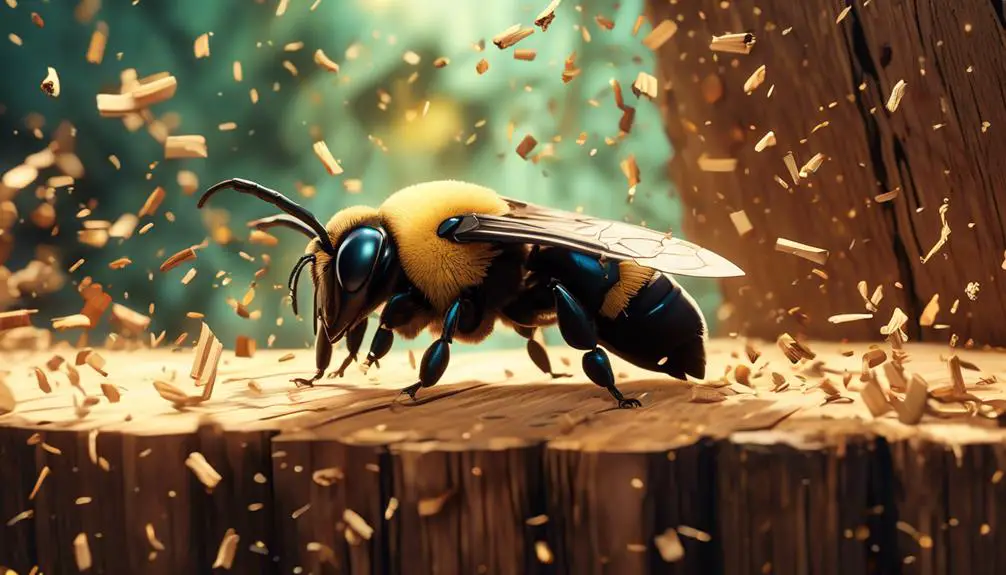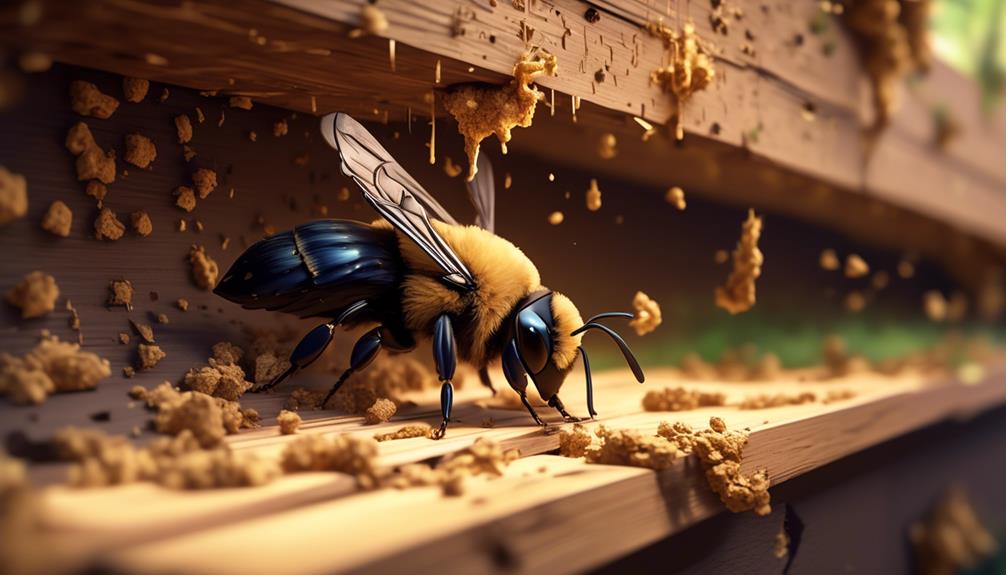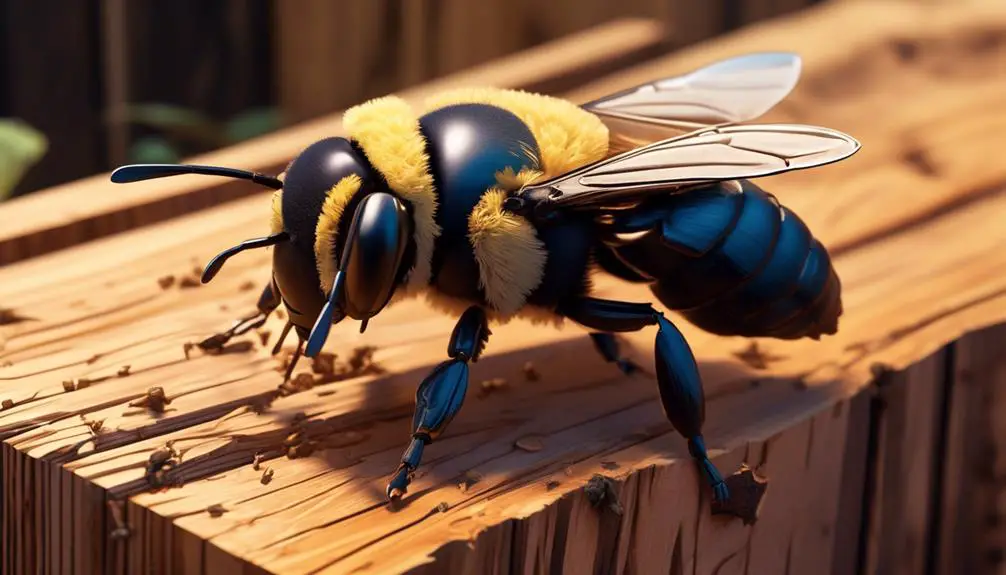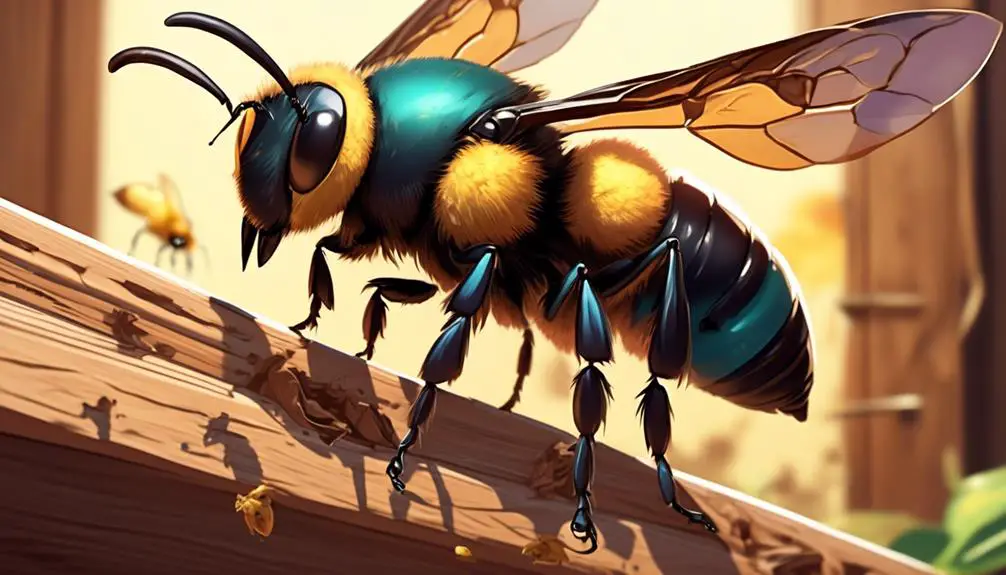Uncover the hidden menace behind the persistent chewing sound of carpenter bees, and learn how to protect your home from their destructive habits.

Carpenter Bee Chewing Sound
Imagine settling into your cozy living room, a cup of tea in hand, only to be disturbed by a faint, yet persistent sound, akin to a tiny woodpecker at work. You shrug it off at first, but as the days pass, the sound persists, and curiosity gets the better of you.
You've got a carpenter bee problem. Now, you're not alone in this, as many homeowners grapple with these industrious insects. So, let's explore the unique chewing sound of the carpenter bee, why it's more than just a nuisance, and how it could be a telltale sign of a much larger issue unfolding within your home's structure.
Stay with us, as we unravel these fascinating, yet potentially destructive creatures, and the measures you can take to keep your peace of mind, and more importantly, your home intact.
Key Takeaways
- Carpenter bees create a distinctive chewing sound while boring into wood to create nests.
- The intensity of the chewing sound varies depending on the type of wood they are burrowing into.
- Identifying the chewing sound is crucial for detecting carpenter bee infestations.
- Carpenter bee infestations can lead to significant damage to a home's structure.
Understanding Carpenter Bee Behavior

To fully comprehend the behavior of carpenter bees, you must first familiarize yourself with their distinctive chewing sound, a crucial indicator of their presence and activity. This isn't your typical buzz; it's more akin to the sound of a tiny woodpecker, a rhythmic and persistent gnawing noise. This sound is produced as they bore into wood to create their nests, and it's often the first sign of an infestation.
Analyzing this sound, you'll find that it's not constant but rather punctuated by brief periods of silence. This pattern reflects the bees' methodical boring process: they chew, then stop to discard the wood particles, and then resume chewing. This understanding can help you better identify their presence.
Moreover, the intensity of the sound varies depending on the type of wood they're burrowing into. Harder woods will result in a softer, more muted chewing sound, while softer woods will yield a louder, more pronounced noise. This distinction can give you some insight into their nesting preferences.
Identifying the Chewing Sound

Having dissected the unique characteristics of the carpenter bee's chewing sound, let's now focus on how you can accurately identify this distinctive noise in your surroundings. It's key to remain alert and attentive, as this sound is often subtle and may be overshadowed by ambient noises.
The carpenter bee's chewing sound can be likened to a quiet, rhythmic scraping, a consequence of their strong mandibles gnawing against wood. It's not dissimilar to the noise produced when someone is sanding wood manually with a fine-grit sandpaper. It's a continuous, low-pitched sound, typically repeated in short bursts.
To accurately identify this sound, you'll need to consider the context. If you observe small, round holes in wooden structures and notice a fine sawdust-like substance (known scientifically as 'frass') in the vicinity, the chewing sound you're hearing could well be a carpenter bee at work.
Impact on Your Home's Structure

Often underestimated, the persistent gnawing of carpenter bees can significantly undermine the integrity of your home's wooden structures over time. Unlike termites, carpenter bees don't consume wood, but they excavate it to create nesting sites, leaving behind a network of tunnels that can weaken the structural integrity of your home.
The primary damage comes from the nesting tunnels, which can extend several feet into the wood. As the infestation persists, the tunnels intersect and expand, creating hollow spaces that compromise the stability of the structure. More often than not, it's the cumulative impact over years that leads to significant structural issues.
Moreover, if left untreated, the same tunnels are reused and expanded upon by successive generations of bees, exacerbating the damage. The presence of carpenter bees can also attract woodpeckers, which are known to cause additional exterior damage while attempting to feed on the bees.
Lastly, the fecal matter and pollen left behind by the bees can lead to staining and discoloration of the wood, further depreciating the aesthetic and monetary value of your home. Therefore, early detection and intervention are essential in mitigating the potential damages caused by these industrious pests.
Preventing Carpenter Bee Infestations

Given the damaging impact of carpenter bee infestations on your home's structure, it's crucial to explore effective preventive measures.
Your first line of defense should be regular home inspections for signs of infestation, such as the distinctive round holes that carpenter bees bore into wood.
Sealing any cracks or holes in your home's exterior with caulk can also deter these pests. Wood preservatives, particularly those containing borate, can be effective too. Borate penetrates the wood, killing carpenter bee larvae and dissuading adults from nesting.
Opt for hardwoods when possible, as carpenter bees prefer softwoods. If you've already got an infestation, you'll need to treat the nests with an insecticidal dust before sealing the holes.
Another preventative measure involves painting or varnishing exposed wood surfaces, as carpenter bees prefer untreated wood.
Lastly, consider professional pest control services. They're equipped with the necessary tools and expertise to effectively deal with carpenter bees.
Professional Solutions for Removal

When you're dealing with a carpenter bee infestation, professional pest removal services offer a comprehensive and effective solution. These specialists possess the knowledge and equipment necessary to safely and efficiently remove these pests from your property.
A professional pest control strategy typically involves a multi-step process. First, a thorough inspection is conducted to identify the extent of the infestation. This involves locating and tracking the bees' flight patterns and identifying entry points in the woodwork.
The second step involves the application of an appropriate insecticide. Professionals use specialized equipment to inject insecticides directly into the tunnels that the bees have bored into the wood. This ensures the effective elimination of the adult bees, larvae, and eggs within.
The final step in professional carpenter bee control is prevention. This may include treatment of the affected wood to deter future infestations, as well as sealing any holes to prevent re-entry. Regular follow-ups may also be scheduled to confirm the success of the treatment and to catch potential re-infestations early.
You'll find that professional pest control solutions aren't only effective but also time-saving and stress-reducing. It's a worthy investment in safeguarding your property from the damaging effects of carpenter bee infestations.
Conclusion
So, you've learned about carpenter bee behavior, recognized their gnawing symphony, and understood the potential harm to your abode.
Prevention is key, but if you're already hosting these unwanted guests, professional help might be your best bet.
Remember, knowledge is power in the battle against these buzzing drillers.
Stay vigilant, keep up with preventive measures, and you'll be ready to tackle any carpenter bee issues that come your way.



